Godetia grandiflorum
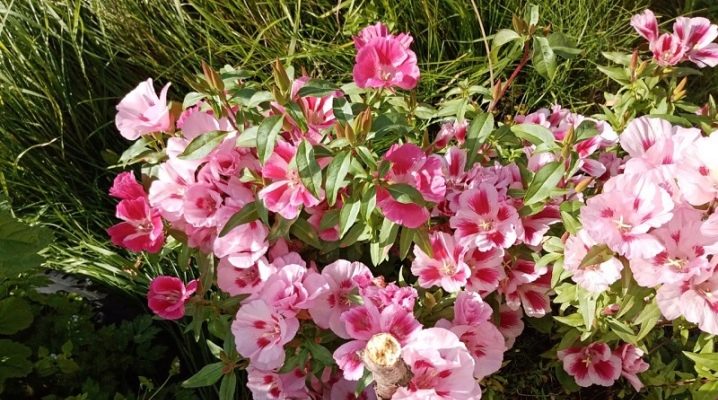
Many summer residents are very fond of flowers. Beautiful bouquets now and then decorate window sills and flower beds. Large-flowered godetia fell in love with many not only for the beautiful appearance of the flowers, but also for the fact that it has a rather long flowering. It is suitable for both single composition and landscape design.

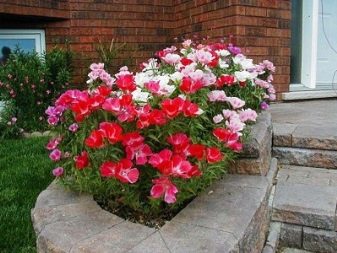
Description
Godetia or, as it is also called, Godetia (godetia) is a representative of annual crops. Belongs to the fireweed family. This species has approximately 20 varieties. The homeland of the flower is Southern California, and it is named after the Swiss botanist C. Godet. It was he who became the first to study the plant in detail and gave it a classification. The flower gained its distribution in the 60s of the XIX century thanks to its unpretentious cultivation and beautiful fragrant flowers, which in some way resemble another variety - azalea. Some may unknowingly confuse godetia with another flower of the fireweed family - clarkia. The shoots of this culture are erect, they are slightly branched. The height of the bush itself can be from 20 to 60 cm. The crown is compact, but much depends on the cultivated variety. In shape, the bushes can be pyramidal or spreading.
The leaves are arranged alternately, in shape they are lanceolate. The color of the plate is bright green, the surface is smooth and slightly glossy. There are intermediate notches along the edges. The flower shape is either cupped or bell-shaped. The diameter depends on the variety. On average, it can vary from 3 to 10 cm. By type, the buds can have 4 petals and be simple, or be double. All flowers, regardless of the type, belong to the cyst-shaped inflorescence. The buds of the plant can be of any color: from red to peach, from dark to pure white, and can also be combined. The peduncles themselves are not long.
The fruit is formed in the form of a tetrahedral capsule, has a cylindrical shape. Small seeds are stored inside.


Varieties
Since the plant has been cultivated since about 1865, a large number of varieties have survived to this day, which differ from each other in size, color and other components. The flower is usually subdivided into 3 main types.
- Large-flowered godetia. It is an upright plant. The bushes are compact and have a height of 20-40 cm. Sometimes, due to their small size, flowers can spread along the ground. At the beginning of the season, the stems are soft, thin, and by the end of the growing season they become more lignified and resilient. Inflorescences can reach 10 cm in diameter. They are cupped or bell-shaped in shape. The flower petals are very delicate and delicate. The color can be pale pink, reddish, wine or lilac. Flowering begins in the 20th of July and can last until October.
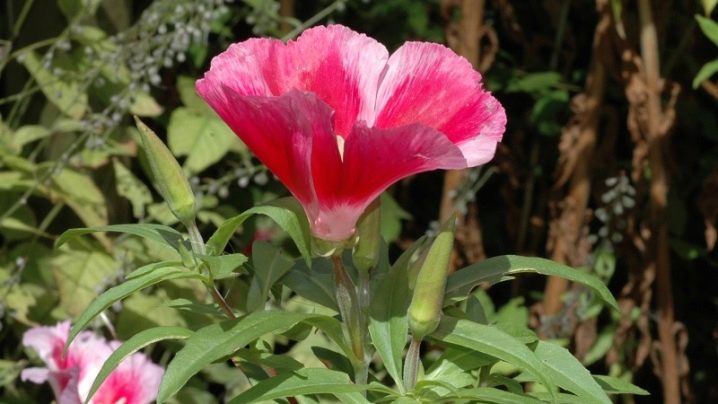
- High godetia can grow from 60 cm to 1 m. The bushes have smooth straight stems, but due to their high growth, they sometimes do not have great stability at the beginning of flowering. The leaves are small, narrow, pointed to the tip. The flowers are 5-6 cm in diameter. The petals are spatulate, the surface may have a scarlet or pinkish tint.
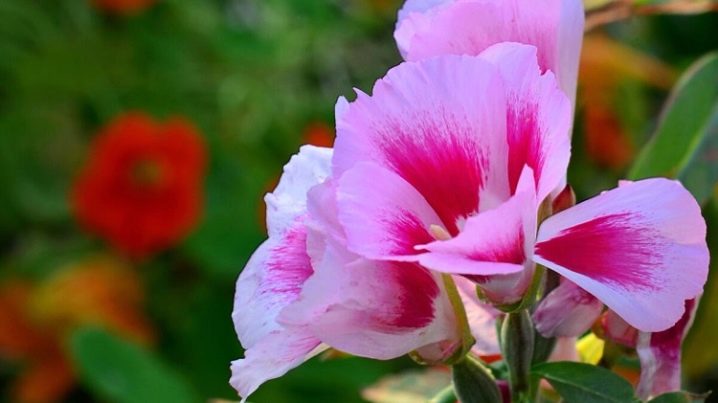
- Terry. It is a subspecies of large-flowered varieties. It is divided into three types: semi-double, double and densely double godets. Sometimes this species is called azalea.

Consider the most common varieties of godetia.
- Sybil Sherwood. These are compact bushes that grow on average up to 40 cm. The stems can be pink or green. The leaves are very elongated and pointed.The flowers are semi-double, the color is usually soft salmon. From the middle of the petal to the edge, the color begins to fade gradually. The diameter of the bud is 5 cm.

- Weiser Straus. Belongs to the large-flowered species. The height of the stem is no more than 35-40 cm. The flowers have a snow-white shade and have a wavy edge. Sepal diameter 6-8 cm. The variety can be grown in northern latitudes, as it is able to survive a drop in temperature.
It should be noted that at the same time the plant is very sun-loving.

- "Bohemia". Compact shrub, suitable for growing in garden beds and in pots. The flowers are of mixed colors. The flowering is profuse and long lasting.

- "Lava". The variety belongs to the semi-double type. Bushes are small, up to 35 cm high. Flowers are large, carmine-red, wavy edge. Unpretentious, can grow in partial shade. The bush has a spherical shape, so it is necessary to follow the planting scheme, especially if the variety is involved in the composition.

- Orange Glory. Medium bush up to 45-50 cm high. Its shape is spherical and compact. Flowers are semi-double, large. The color of the petals is light orange with a slight pink dusting.
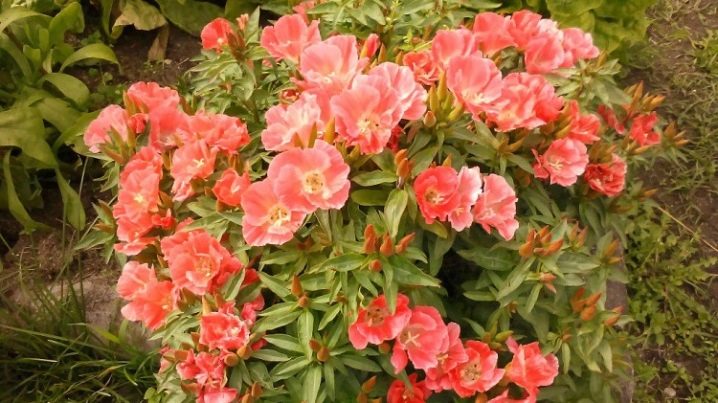
- Maiden Blush, or Maiden Blush. Large-flowered godetia suitable for growing in pots, boxes or in the field. The height of the bush is 40 cm, they are lush and voluminous in shape. The flowers are deep pink. The diameter of the bud is 5-8 cm, and the edge is wavy.

- Rembrandt. Hemispherical bush 35 cm high. Leaves are lanceolate, elongated, green-pink shoots. The flowers are pink with a wavy edge. Sometimes red spots appear on the petals.

- "Meteor". It has rich carmine-colored buds with a red tint. The inflorescence is densely double. The petals are elongated and glossy. It is necessary to plant this variety with a distance between the bushes of at least 40 cm.It is with such a planting that the bush will be able to fully open.

Planting and leaving
Godetia are grown in two ways: by independent sowing or purchased seedlings. You can germinate seeds directly in the open field or at home through seedlings. If you apply the first option, then sowing should be carried out in the second half of April. In the southern regions or in places with a warm and temperate climate, planting can be done in the fall (it is also called "before winter"). Regardless of the season, the material must be pre-processed.
For seedlings, seeds begin to be harvested towards the end of March - early April. At the same time, containers are being prepared. At the bottom, it is necessary to pour a drainage layer, and then fill the containers with loose earth mixed with useful minerals and sand. The treated seeds should be spread evenly over small, deep trenches and covered with an even layer of earth on top. The container is covered with foil and removed to a warm place. It is worth ventilating the box every day and at the same time you can water future seedlings. Seeds germinate in 14-20 days. After germination, the film is removed, and the pots are rearranged on the windowsill. Growing from seeds will not cause difficulties even for novice gardeners.


Subsequent picking is done with the calculation of where the culture will be grown next: in a pot or on a plot. No more than 2-3 seedlings should be planted in a pot. Disembarkation should be done on a cloudy day, early in the morning. The distance between the bush and another plant should be at least 15-20 cm. But a lot will depend on the variety. Caring for a flower will include periodically loosening the soil, while removing all weeds around. Thanks to this, the plant will be strong and strong.
Watering is systematic and abundant, as well as top dressing. For abundant flowering, fertilizer must be applied every 3-4 weeks. Usually various mineral fertilizers (potassium, nitrogen, phosphorus) or nitrophoska solution are used. If the bush begins to slope, then it must be tied to a support. After flowering, you need to collect the seeds.This will happen 4 weeks after the flower has faded. The box will begin to gradually change shade and darken. In this case, it is carefully cut off. Next, the box is slightly incised, and the seeds are poured out of it.
The resulting seed can be used for 4 years.


Examples in landscape design
Large-flowered godetia is actively used in landscape design.
- This flower is in perfect harmony with other plants in the flower bed, and can also be used as the only variety in round beds. For example, the Weiser Ostrich variety can be planted along curbs or more complex compositions can be made with it.

- But "Orange Glory", on the contrary, will become either the center or the front of the garden.

- And also designers note that all tall plants look better in the center of the flower garden, and dwarf ones - along the edging or on the edge.

Most often, godetia is used in a composition with small-flowered plants, such as:
- ageratum;
- lobelia;
- gatsaniya;
- eschsholzia.
In a bouquet, the flower will look good with decorative deciduous varieties (for example, with cineraria and Byzantine stachis).








































































































The comment was sent successfully.